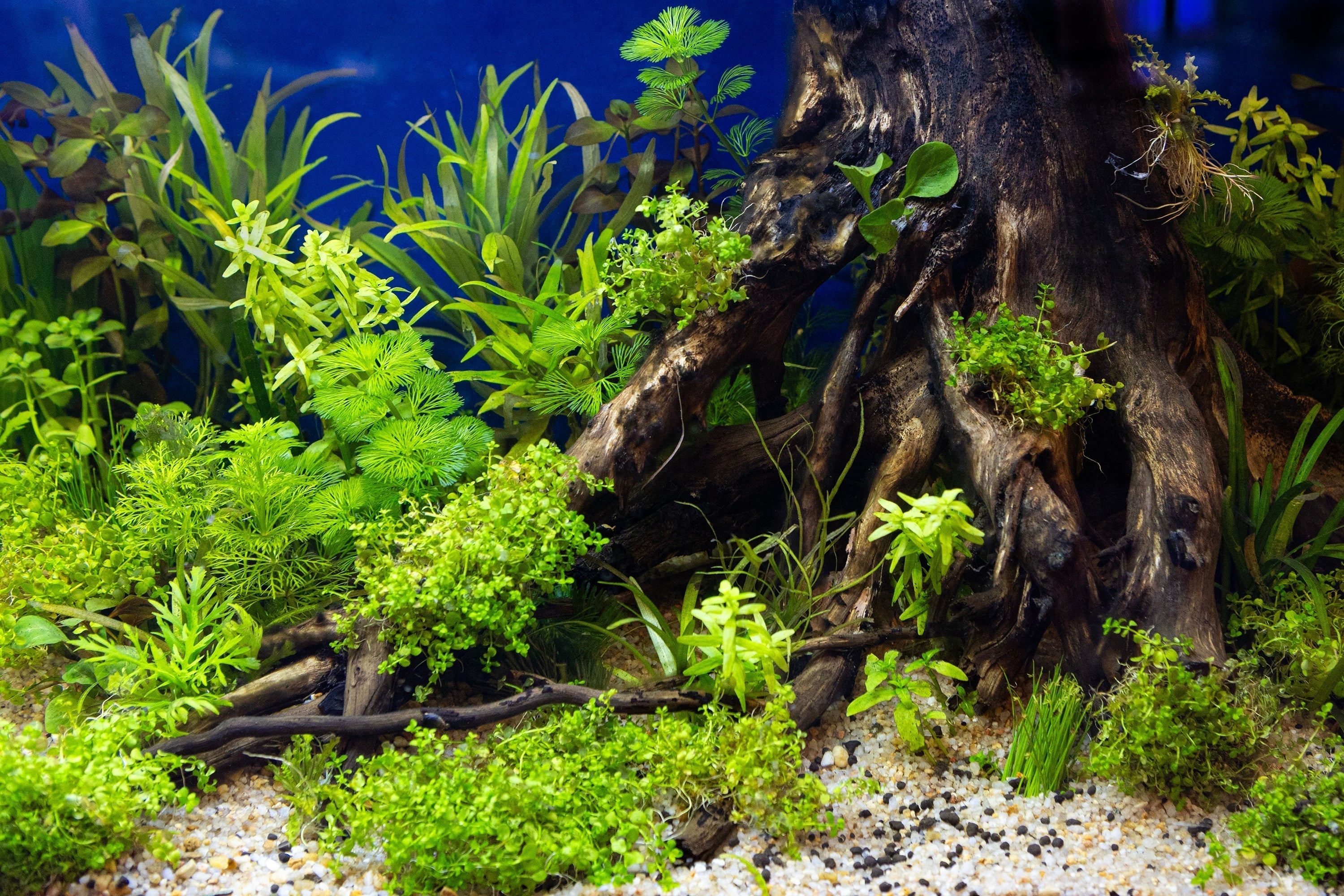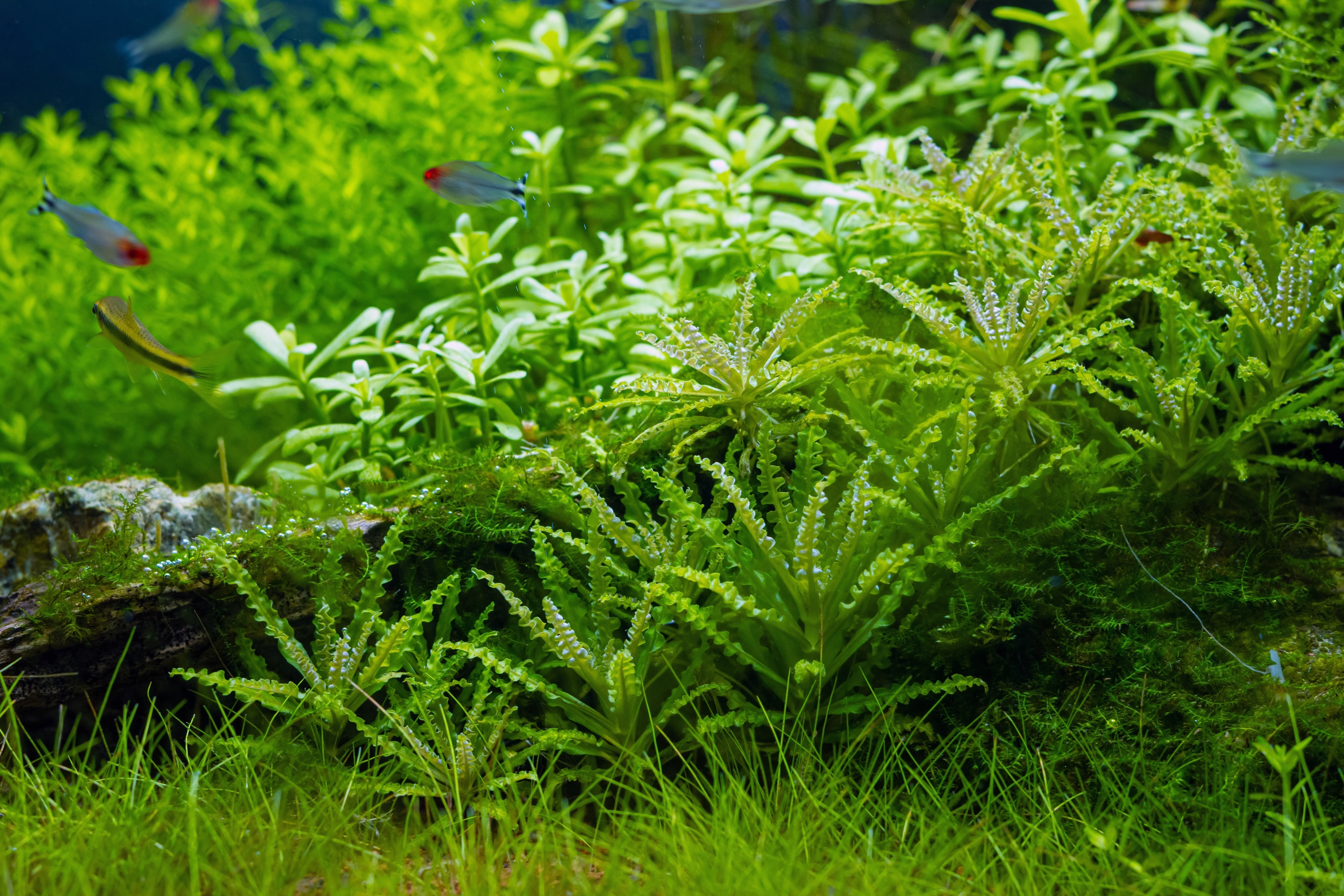Table of Contents
The world of live aquatic plants is always attractive to the fishkeeping community. Among the popular species, Anubias often appears to be the favorite of almost everyone from beginners to seasoned aquarists. What makes this genus so famous? Let’s discover together…

(Image of Anubias Nana Petite on Java Rock )
What is Anubias Plants?
Anubias plant are native to Western Africa. The name Anubias does not indicate a specific species yet, a genus of aquatic and semi-aquatic flowering plants in the family of Araceae. You may easily encounter them along the banks of rivers and streams, often submerged or emersed wherever shady areas are.
Anubias is notable for its lush thick green leaves (despite not all of them, for example, Anubias Coffefolia has brownish hue) and strong roots structure. Its varieties usually share the following similarities.
- A thick and dark stem
- Average height around 6 to 8 inches
- Sometimes bloom a whitish/ creamish flowers
- Leaf shapes are various from broad, wide to oval or heart-shaped or even elongated and pointy
- Rhizome species
Of all the available in aquarium trade, Anubias Congensis, Anubias Barteri, Anubias Frazeri, Anubias Nana, Anubias Nana ‘Narrow Leaf’ are the common names. Their hardy and undemanding characteristics make them best suited to many tank conditions, even low-tech ones.
Anubias Congensis:
Anubias Congensis is catching a quick glimpse of A. Congensis, you will be surprised by its vivid green and elongated leaves. With an average height of up to 6 inches, it is usually considered as a foreground or midground plants in an aquarium. Like other types of Anubias, it can grow under low lighting conditions and tolerate a wide range of water parameters.
Anubias Barteri:
Anubias Barteri commonly cultivated in many home aquariums, Anubias Barteri is more popular than other types of the same genus. The variety grows well either in emersed or submerged environment, and also known for tolerating a wide range of lighting conditions. Considering its size, Anubias Barteri generally planted in the midground or background of planted aquariums.
Anubias Frazeri:
Anubias Frazeri is a hybrid of the well-known Anubias Barteri and Anubias Congensis, possessing deep-green narrow pointed leaves. Anubias Frazeri can endure a variety of water parameters and thrive under low to moderate lighting conditions. Its ideal height from 6 to 8 inches makes it perfect for midground to background in planted aquaria.
Anubias Nana:
Anubias Nana or Anubias Nana Petite is a green striking in the foreground or midground of planted aquariums. A. Nana has dark green leaves emerging from the center of the plant like a small blossom underwater, which will create a vigorous aquascape and natural-looking habitat for your tank. It is best known for recovering from basic cultivation mistakes as well as surviving in a wide range of environments.
Anubias Nana Narrow Leaf:
Anubias Nana Narrow Leafsharing similarities of Anubias Nana except for its leaves which are a bit more narrow and compact. A. Nana Narrow Leaf is short, bushy and tolerant of almost any living conditions. It is also a sturdy plant thus, it is an ideal option for those tanks having larger fish.
Benefit having Anubias as live aquarium plants:
Like many other live aquatic plants, Anubias benefits your aquarium in many aspects. The species is a good choice for beginners to try on. As it does not need you to enhance or equip your tank with any special devices to meet its requirements. Further, it provides shade and hiding places which are needed for your fish or shrimp when they seek refuges. That has not mentioned its abilities in oxygenating your aquarium and providing surface areas for beneficial bacteria to live on. To those who are gifted with aquascaping taste, Anubias will make their tanks shine.
Having a general knowledge of this genus is good but not enough if you intend to plant it. The wild specimen and the one cultivated in aquariums may have slightly different demands in terms of living conditions.
Tank size is always the first to come. Since we are not talking about a specific species, you should be aware of the type of plant you are going to keep. Anubias varieties do not usually have the same height nor growth tendency. Some are tall while others are short. Some grow upward while certain prefer spreading horizontally. As such, there are many options when it comes to tank size. Generally, it is widely recommended that a minimum of 10-gallon aquarium be fitted to small to medium types, whereas 20-gallon or more deem better to those larger. Nevertheless, they are just for reference. You need to do an advanced search to find out the appropriate tank size for your specific plant. This is important as it helps your aquatic plants accommodate well and won’t be stuffy for other inhabitants.

(Image of Anubias Plant)
What is Anubias Plant Light Requirements?
As you may know, in the wild, most Anubias thrive in shady areas. This means they prefer the similarity in tank environment, moderate to low lighting. That said, different varieties may require different lighting ranges. Hence, it’d be better if you do a little check by yourself or with the pet store owner.
Fun fact: Light affects other inhabitants as well besides live aquatic plants. If you notice, too much light is usually a cause of algae bloom, especially when your target plants are Anubias. Algae loves Anubias and under intense lighting conditions, your Anubias may grow fast but sure, the algae, too.
What is water parameters for Anubias Plant?
Water parameters are another issue that aquarium plant keepers cannot skip. Anubias is hardy, tolerant of almost any living conditions, and some species are even able to recover from basic cultivation mistakes of beginners. Nonetheless, providing your plants with appropriate water parameters and keeping them stable are necessary, as they not only need surviving but flourishing as well. According to many skilled aquarists, the proper temperature range for this plant is between 68° - 82°F (around 20° - 27°C), and a neutral pH zone of 7.0 with KH level around 3-8 dKH would not be more ideal.
Anubias does not actually need supplements. If they are doing well, let them be. However, if you still want to inject some, they will appreciate and respond positively.
Good to know: The species mainly feed from the water column. Hence, it had better use liquid fertilizer instead of nutrient-rich substrate.
As we mentioned above, Anubias varieties are different in terms of height. Placing it in the foreground, midground or background will depend on the height of the specific plant you’re going to grow. However, fortunately, to ‘anchor’ it to the tank is a quite simple process. You can either bury its roots into the substrate or attach them to hard surfaces such as rock or driftwood. Go with the former, you should carefully not bury its rhizome (where the stem and roots grow out from). Otherwise, your plant will soon rot.
If you choose to attach them to hard surfaces, you can use fishing line or glue. Locate the area you want to plant Anubias, then use a fishing line to bind it gently to that area until it is fixed. Do it slowly and carefully to avoid any damage to the rhizome. If you opt for glue instead, spread a thin layer of glue on the area (with the recommended length similar to that of the rhizome), then press its rhizome on the glued part. Hold it firmly until it is dry and attached, then put them back into the aquarium.
Always remember to quarantine your Anubias before you plant them in the aquarium. The plant may carry with itself harmful substances or parasites which may adversely affect your whole tank community.
How to propagate Anubias Plant or Rhizome plant?
Anubias propagative means is through rhizomes. If you want more of it, all you have to do is separate its rhizome (snap or cut it by a sharp pair of scissors are all acceptable). Then plant them in the ways we’ve introduced. However, if you let them grow naturally, they are able to propagate by themselves with plantlets.
Good to know: Although it depends on the variety, many Anubias grow upward rather than outwards. They can even grow partially submerged and fully submerged. The flexibility makes this species attractive to not only aquarists but terrariums hobbyists as well. Anubias is relatively slow-growing but when emersed, it is interestingly vice versa. Their leaves will also be larger and thicker. With proper care, either form will definitely ‘shine’ your tank in their own ways.
At Splashy Fish Store, we supply a wide range of Anubias which comes from reliable sources and grow fully submerged. We further guarantee that all of our live aquatic plants go through the quarantine process for a period of 14-day before sale. We care about the quality and strive to provide you the best quality we can. Visit our Live Plant store to find what surprise is waiting for you.


























